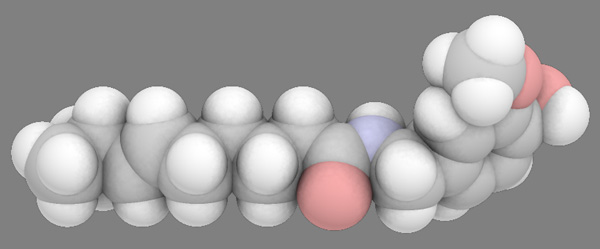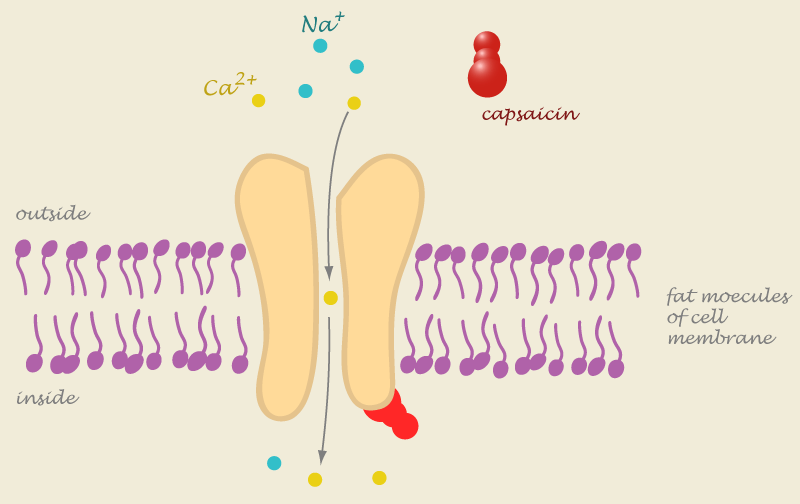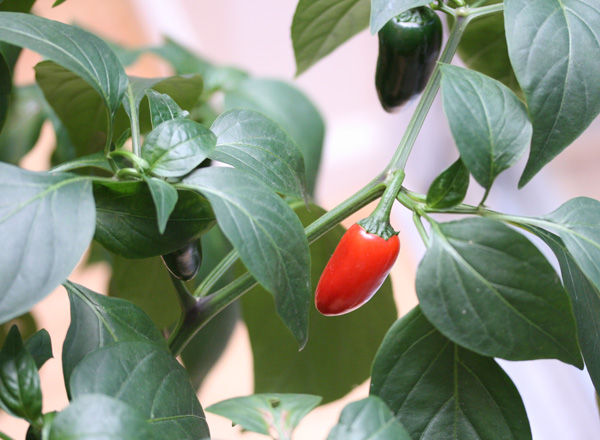Chili com apples

You can add tabasco sauce to a dessert. For many years I have been making an apple-pear pie for Thanksgiving where one of the ingredients is a spicy pepper and vinegar sauce. The sauce does add flavor, but most people cannot quite tell what the different flavor is. This month, Binshtok, Bean and Woolf in a Nature article offer a hint of why it may be useful to add small amounts of hot sauce to your food.

Our brains sense the world through specialized nerve cells. For taste, two different mechanisms are used:
- Saltiness and tartness are detected through ion channels, small openings in the cells that allow the atoms of salts or the atoms of acids to go into a cell.
- Other flavors are detected by special molecules — G proteins — attached to the surface of nerve cells in the taste buds.
The burning sensation of chili peppers is caused by capsaicin. Capsaicin irritates nerve endings in the mouth and tongue, which the brain interprets as a burning sensation. It is not technically a taste because the burning sensation is not being produced by the nerve cells of taste buds.
There are many different types of ion channels. One of the channels on nerve cells, TRPV1, is activated when capsaicin attaches itself to it. The activated channel lets calcium into the cell, which eventually triggers a signal to the brain. The nerve signal itself is an electric current created by opening and closing other ion channels that let potassium or sodium in the cell. (Once inside the cell the ions need to be pumped out. For that, ATP needs to be burned, so thinking does burn calories.)

The TRPV1 ion channel is also activated by heat: it helps the nervous system detect objects that my burn us. To the nerve cell, if the TRPV1 channel is letting calcium in, then that sensation is what we call hot. That is why we interpret the action of capsaicin on our nervous system as heat.
Capsaicin is unique to peppers. It is a very strong irritant and in laboratories it is handled with gloves and masks. For many years it was thought to have no flavor: no taste and no smell. Barry Green, at Yale, and collaborators reported in 2003 that about half the of the people they tested taste capsaicin as bitter. All, including those that did not taste the bitterness, still reported the burning sensation. The bitterness is surprising because it results from the G-protein mode of taste detection and not from the activation of ion channels. There have been some reports of capsaicin tasting salty, but that seems to be rare.
The work of Binshtok and collaborators showed that capsaicin can let a larger molecule (an analgesic called QX-314) into the cell. This molecule is as large (it weighs 263 g/mol and is shown above) as many of the volatiles that give food their aroma and there is the possibility that we may be tasting our smells.
No-heat chilies
It is possible to have jalapeños with almost no capsaicin. For those chili lovers this is heresy. I am one of those chili lovers, but over the years my stomach has become sensitive to the spiciness of chilies and I have been forced to limit how much I consume. But chilies also contribute other flavors to dishes, so in the early 1990s, Lou Rasplicka decided to create a no-heat jalapeño.
Others had tried no-heat jalapeños, but they had eliminated most of the flavor with the heat. Lou decided to take a more scientific approach to the process. He cross-bred jalapeños with a variety of sweet peppers and then selected the fruits based on gas-chromatography measurements and taste tests. It took eight or so generations to perfect the fruit. Peppers are self-pollinating plants, so for the cross-breeding to work, the male parts have to be removed flower by flower. After a few plants are developed, they have to be tested in farms, which may require a few more generations.

This year I decided to try the no-heat jalapeños. I purchased the False Alarm seeds from Burpee, sprouted them, transfered them to a small pot, and later to a larger one, and this week I got my first red ripe jalapeños. There is a little burn to them, but not more that black pepper or ginger.
For the cook
Chilies have been used in coking for at lest 6000 years. The starches that are part of the chili fruit (there is more than fire to a chili) have been found in grinding stones and pots throughout Central and eastern South America, as reported by Linda Perry and collaborators.
Science is still trying to untangle the effects of capsaicin on flavor. The more one eats of it, the less sensitive one is to it. Despite its irritant effect, capsaicin is associated with pleasure because of the release of endorphins. Alcohol increases the hot sensation and the there seem to be no natural compounds that diminish the heat (but there are a few synthetic compounds such as capsazepine). Starting with the work of Lawless and Stevens in the mid-1980s, there have been many reports on how capsaicin changes taste. Many of the results are contradictory and part of the problem seems to be that people perceive heat differently. Just like there are super-tasters (more sensitive to bitter tastes) and regular tasters, there are thermal tasters, people that will perceive taste when spots of their tongues are heated. Thermal tasters and non-thermal tasters respond differently to capsaicin.
When using chili keep in mind that:
- Alcohol will make chili taste hotter, that is why it is so hard to pair wine with spicy-hot food.
- Cold food can temporarily take the burning sensation away, so if want to mix alcohol and chili, cold beers or cold sweet whites may work better. The sugar and coldness of ice creams also work well.
- Capsaicin is not water soluble, so use oils or alcohol to carry its flavor in recipes.
- Milk products with some fat are the most recommended means to lessen the burning sensation from the mouth.
- The whitish placenta of the chili fruit has the most capsaicin. Remove it to cut some of the heat.
- Be careful when handling chilies. They can burn the skin in your hands.
Apple and pear pie
I have been changing this recipe for several years now and I cannot remember where it came from. Any help in providing the proper credit would be appreciated.
Apples and pears are used for the filling of this pie. The fruit must be flavorful, as little sugar is used. The crust is made with sour cream, which gives it an unexpected, but pleasant flavor. The tabasco sauce cannot be detected once the pie is cooked and it enhances the flavor of the pie.
I find two things difficult in making a fresh fruit pie: adjusting the sweetness for the type of fruits used and baking the pie long enough so the filling cools down to a firm mass, but the crust does not burn. It is easier to make an open lattice pie, as it allows the liquid in the pie to be monitored as the pie cooks.
For the crust you will need:
- 2 1⁄4 cups pastry flour (8 to 10% protein)
- 1 tablespoon sugar
- 1⁄2 teaspoon salt
- 3 tablespoons shortening
- 1 cup unsalted butter
- 1⁄4 cup sour cream
In a large bowl, combine flour, salt and one tablespoon of sugar. Cut in butter and shortening until coarse crumbs are formed. Using fingertips break the butter and the shortening into lentil-sized pieces, coating each piece with flour. Mix in sour cream. Keep mixing until dough forms a ball. Adjust the dough (it should be soft as play dough): add cold water by the tablespoon to soften; add flour by the tablespoon to dry. Wrap dough ball in plastic wrap and allow to chill in the refrigerator for 1 hour.
Once chilled, take dough out of refrigerator and cut it in half; keep one half covered and in the refrigerator. Make the other half into a ball. Flour.
Roll the dough into a thin sheet. The dough is going to be sticky as it warms up, so roll out on wax paper to 1⁄8 of an inch with light pressure. Roll from the middle out, turning the dough by quarter turns as you stretch it. Dust with flour as needed.
Invert into pie pan. Trim overhanging edges of pie crust.
For the filling you will need
- 3 large Granny Smith apples — peeled, cored and sliced
- 2 Bosc pears — peeled cored and sliced
- 3⁄4 cup sugar
- 3 tablespoons tapioca flour
- 1⁄2 teaspoon ground nutmeg
- 1⁄4 teaspoon cinnamon
- 1 tablespoon butter
- 4 drops of Tabasco sauce
- 1⁄8 teaspoon lemon juice
- 1 egg, beaten
Preheat oven to 450 degrees F. Grease a 10 inch pie pan.
Place apples and pears into large bowl. Add sugar, flour, nutmeg, cinnamon, butter, lemon, and Tabasco sauce. Toss well in bowl until slices are well covered. Taste a few slices and adjust the sweetness by adding the sugar a tablespoon at a time. Pile up high in pie shell, as it will shrink once baked. Place pie in refrigerator while top crust is rolled out.
Remove second half of the dough from the refrigerator. Roll out to 1⁄8 inch. Cut the dough in strips and create a lattice over the fruit slices. Wet the edges of the strip and join them to the lower pie shell. Brush the lattice with beaten egg.
Place in pre-heated oven and bring down temperature to 325 F. Bake for approximately 45 minutes. The fruit liquid should boil for around ten minutes. This assures that the pie will be dry once it has cooled down. Allow pie to cool down for at least an hour before serving.
For the pie, choose an apple that will hold up to the baking, like the old-favorite, Granny Smith. A list of other apples can be found in The Splendid Table site. The Red or Golden Delicious, while great to eat out-of-hand, will almost melt in the pie.
The tapioca flour is used as a thickener for the filling. Without it the pie will be runny and fall apart. Don’t use cornstarch as it does not survive the higher temperatures that arise in baking. Even the tapioca flour is not the best choice. If you don’t mind using the modified starch sold commercially as ClearJel, replace the tapioca starch by ClearJel one-to-one. ClearJel is what makes commercial pies firm.